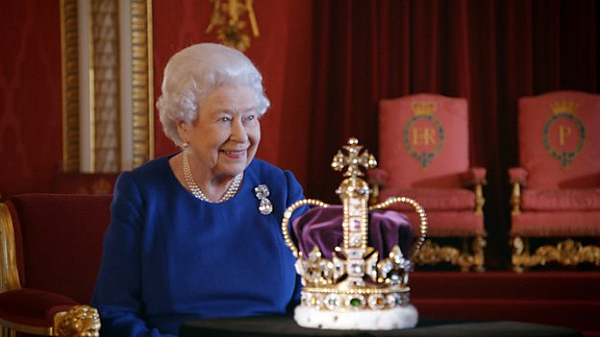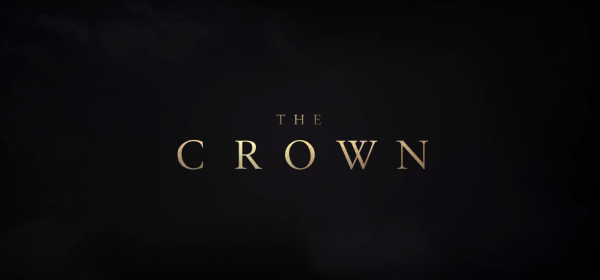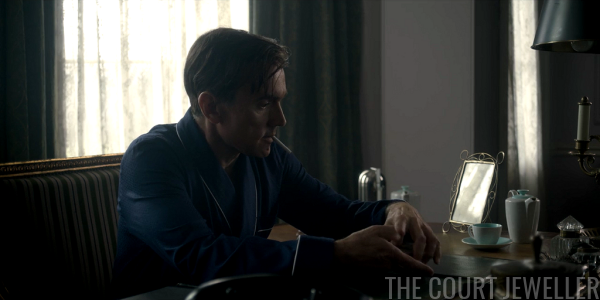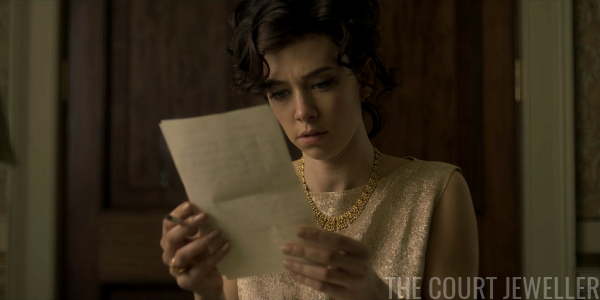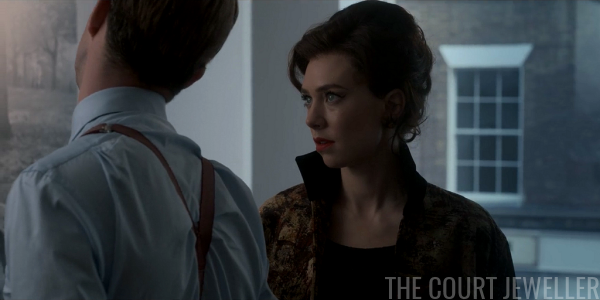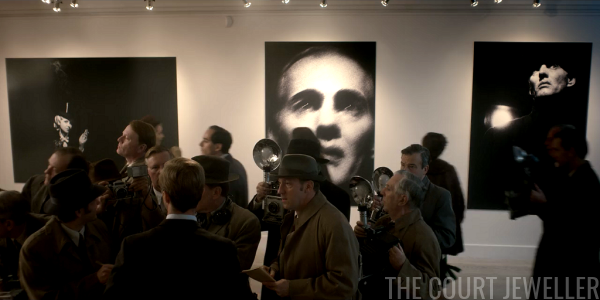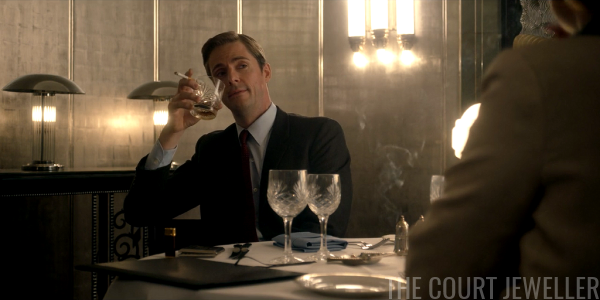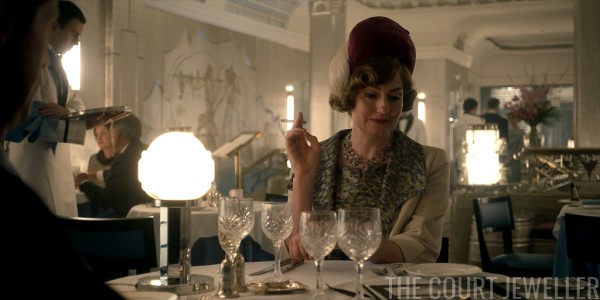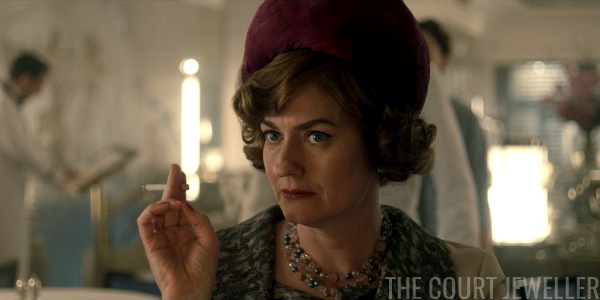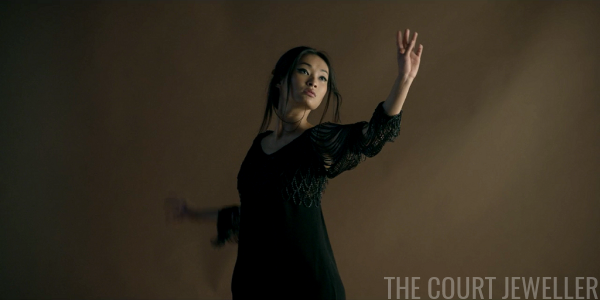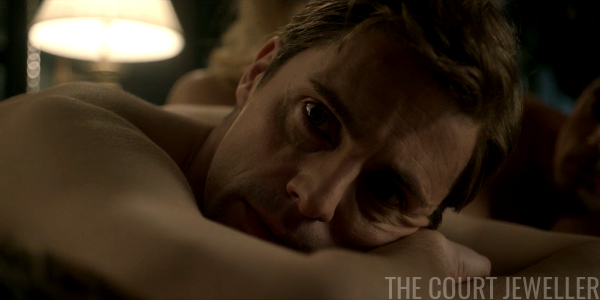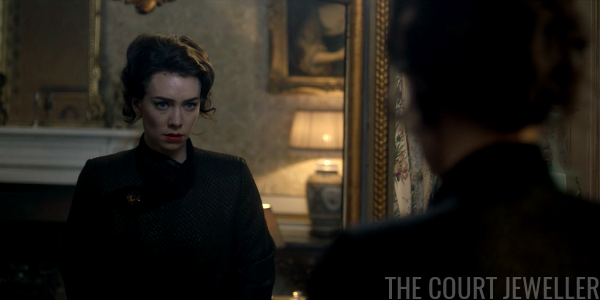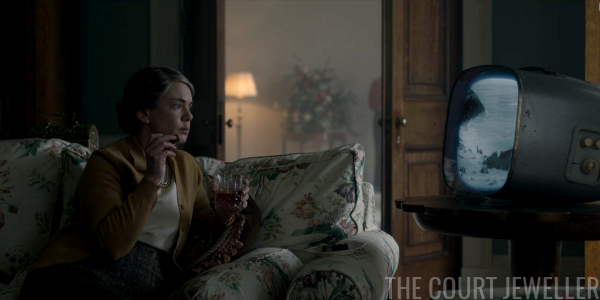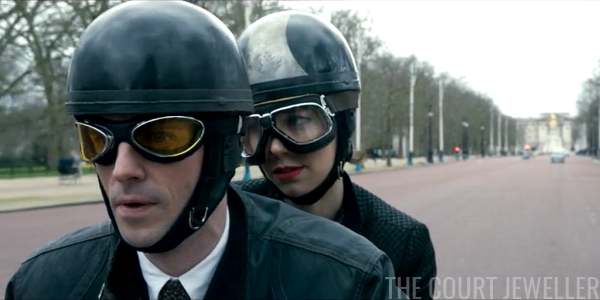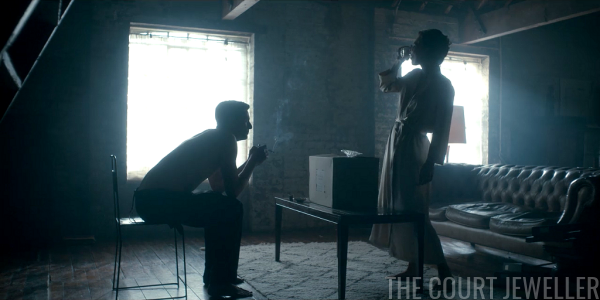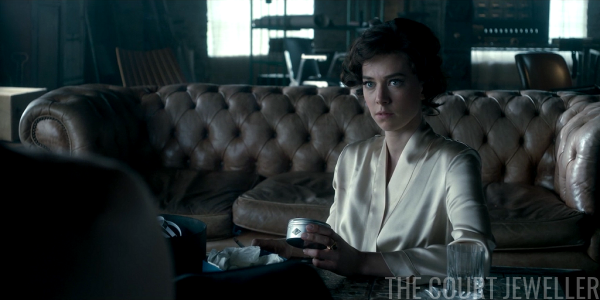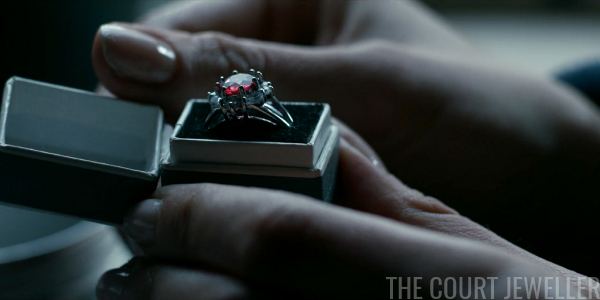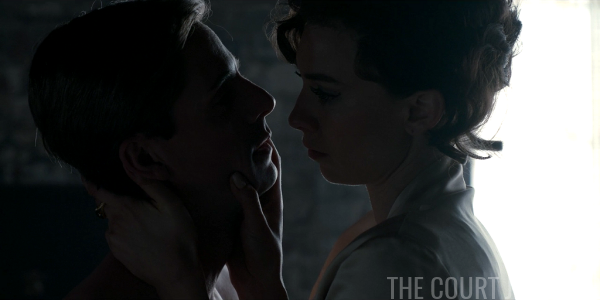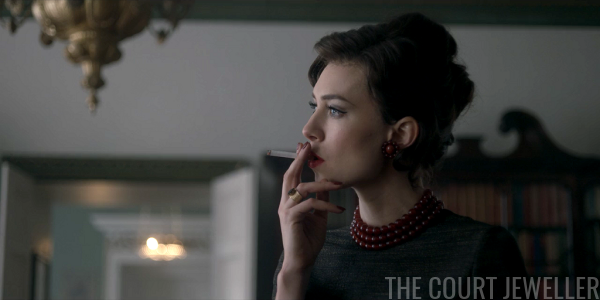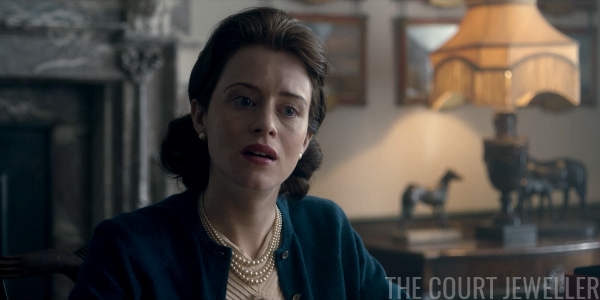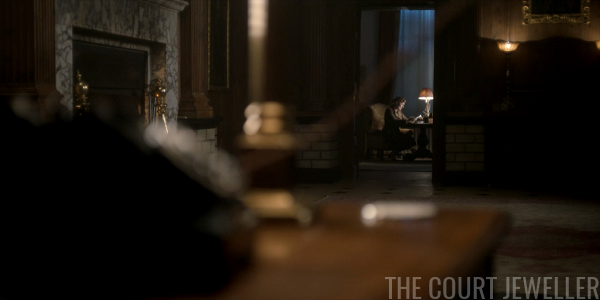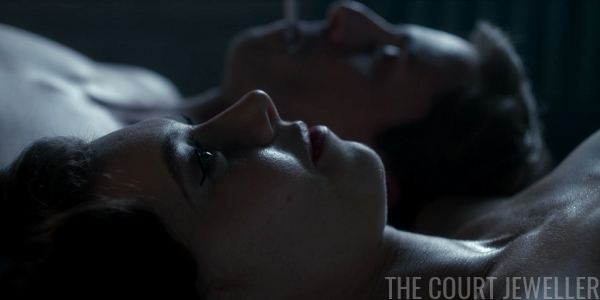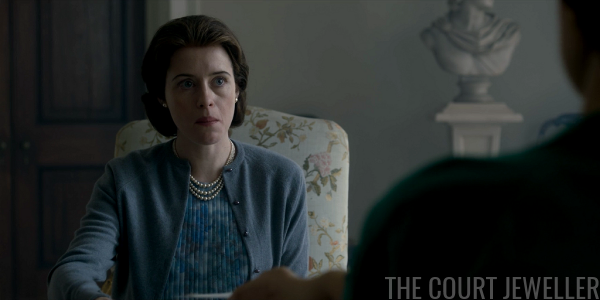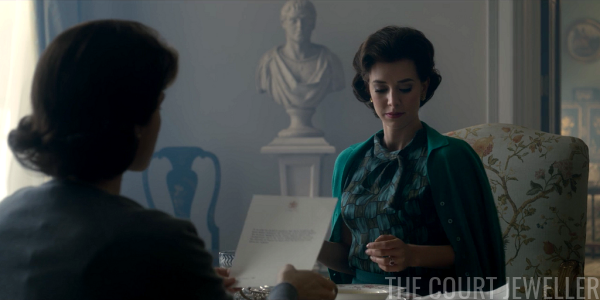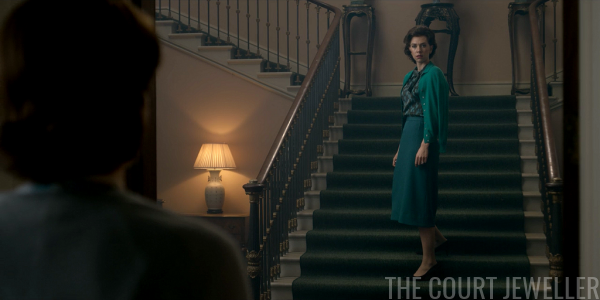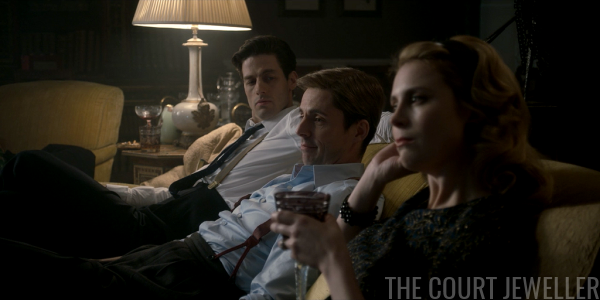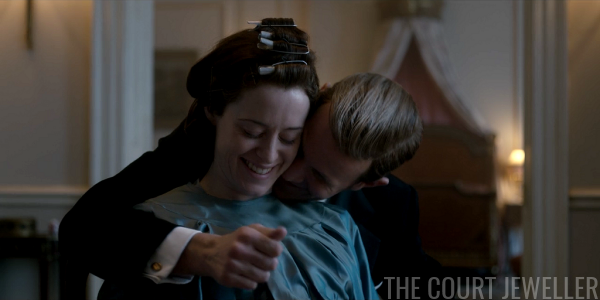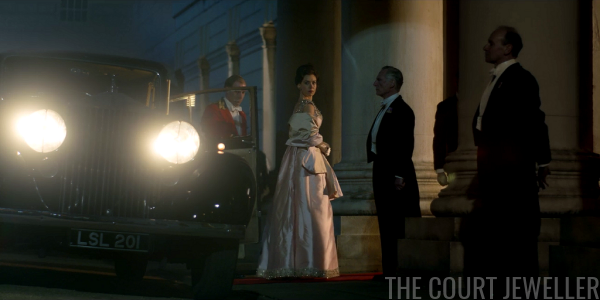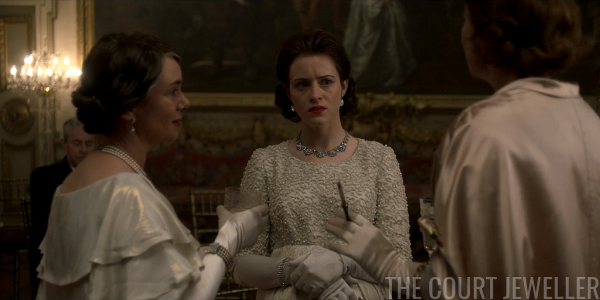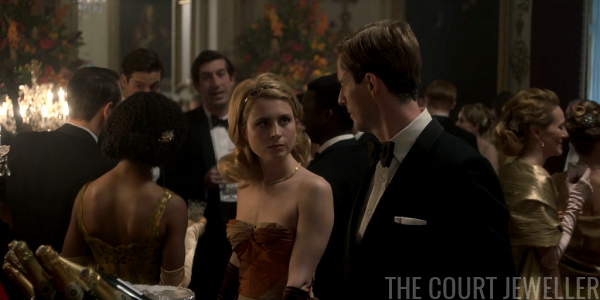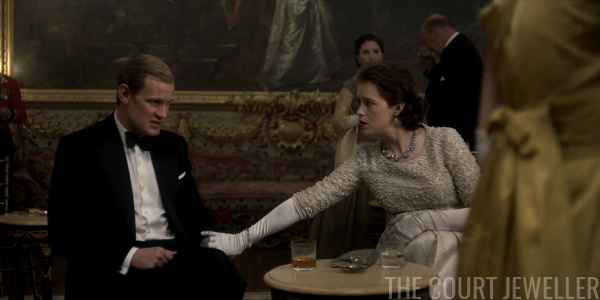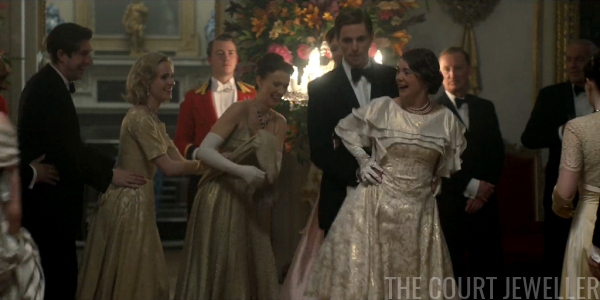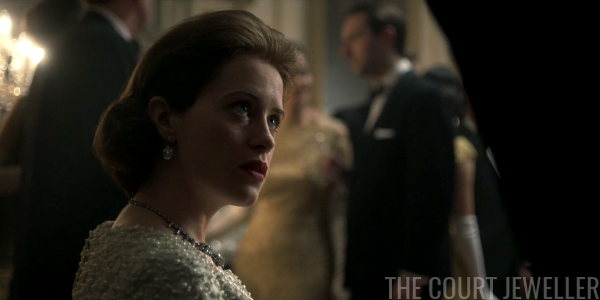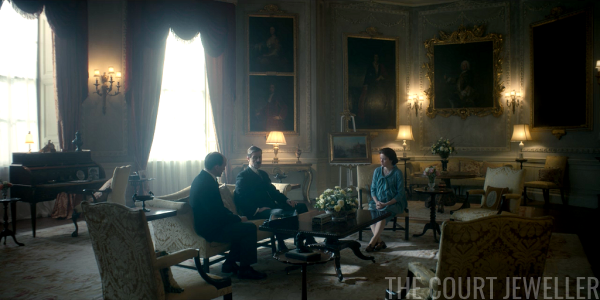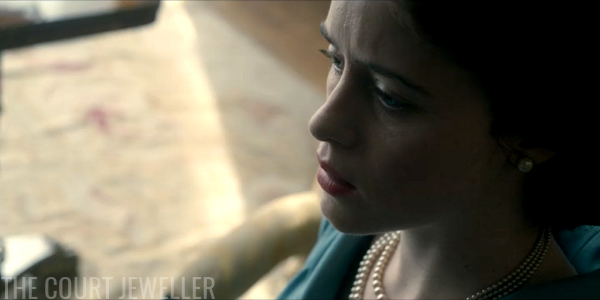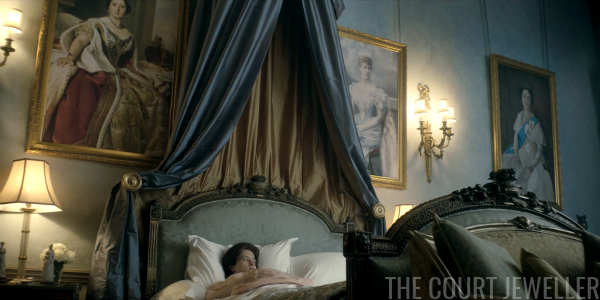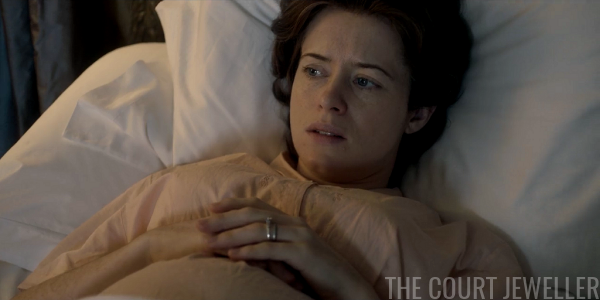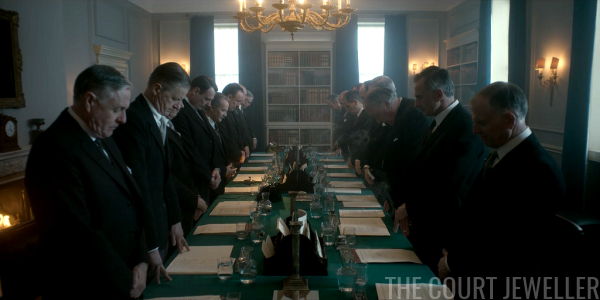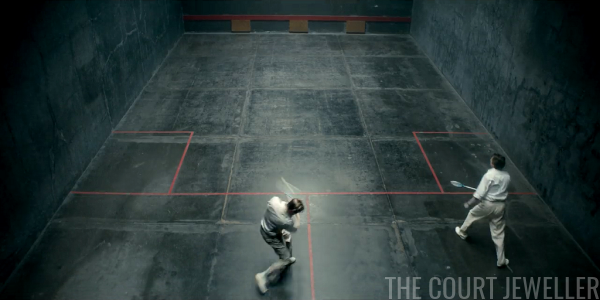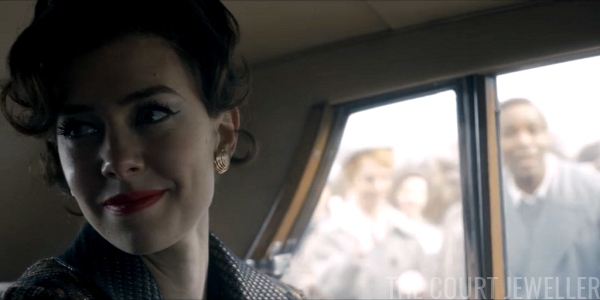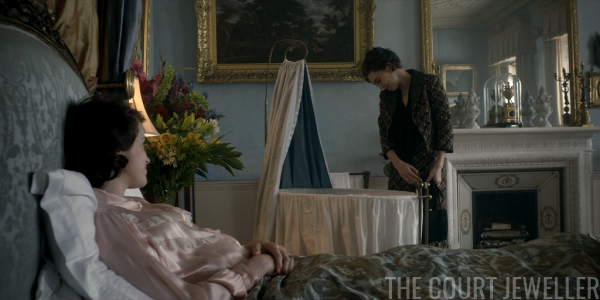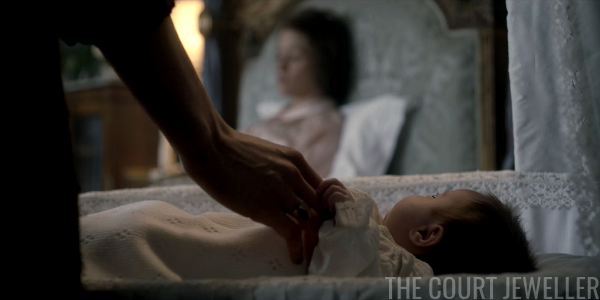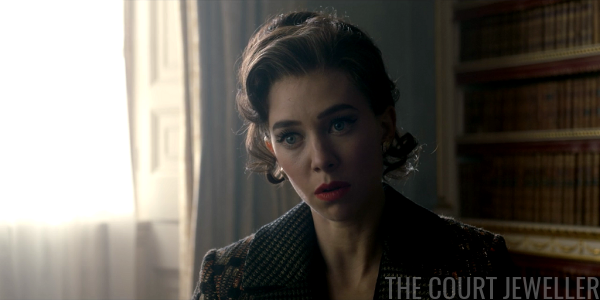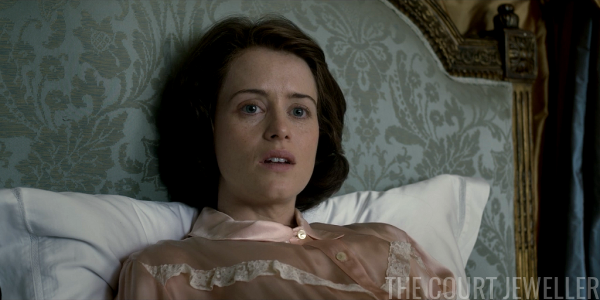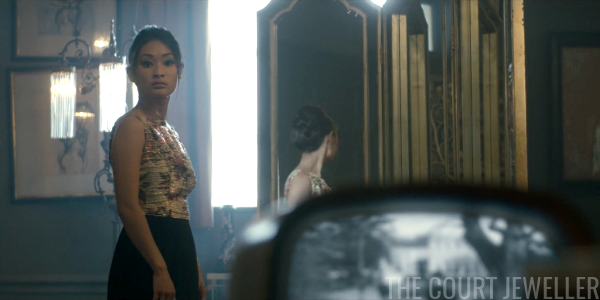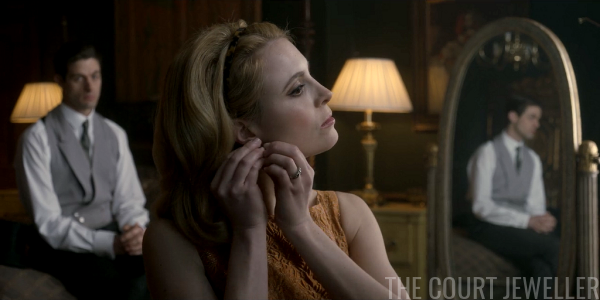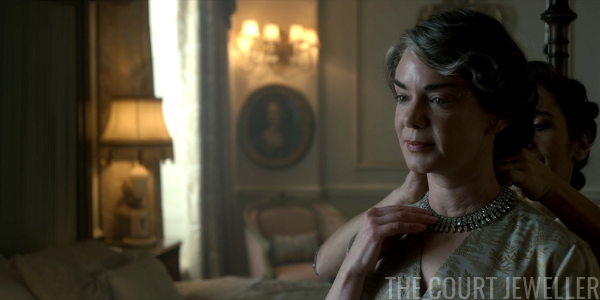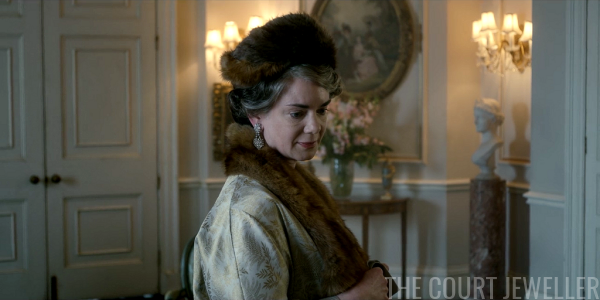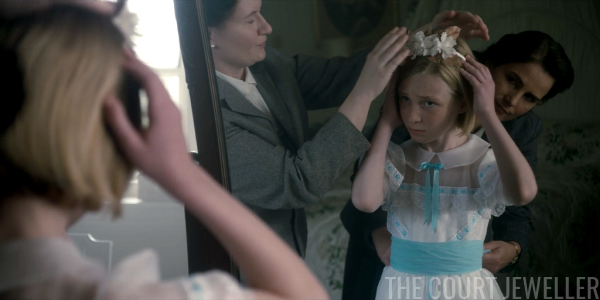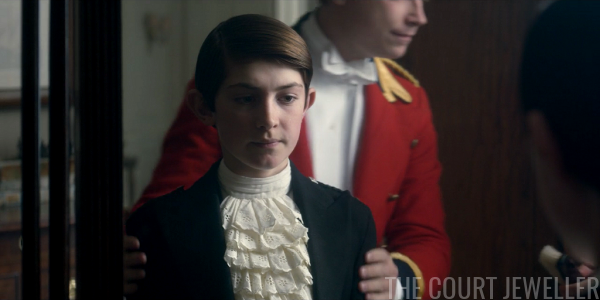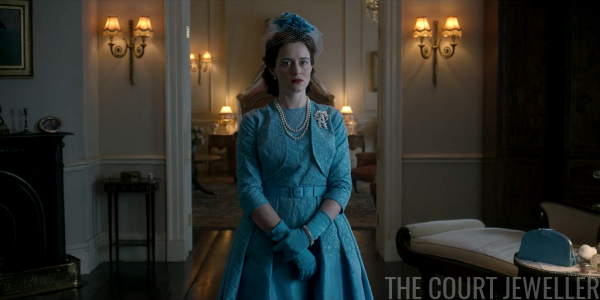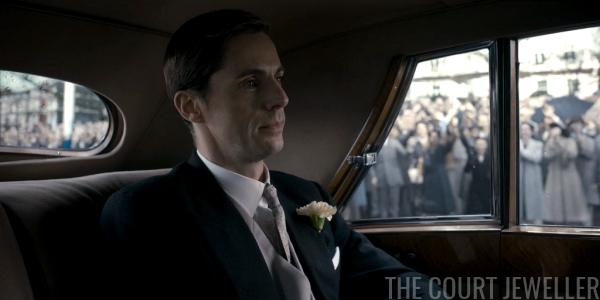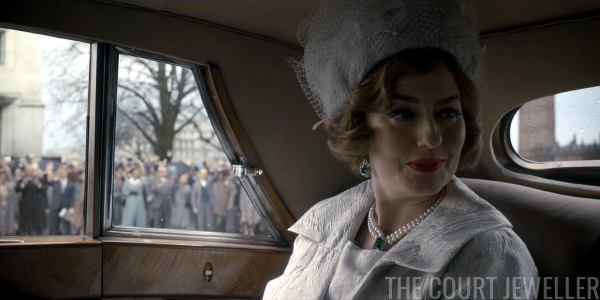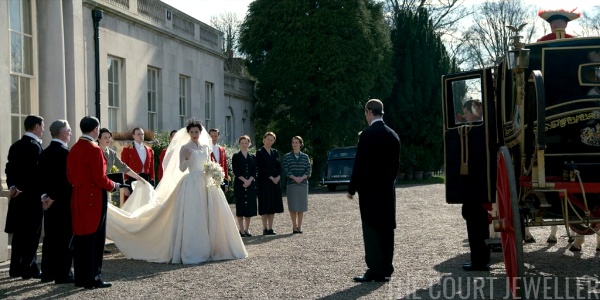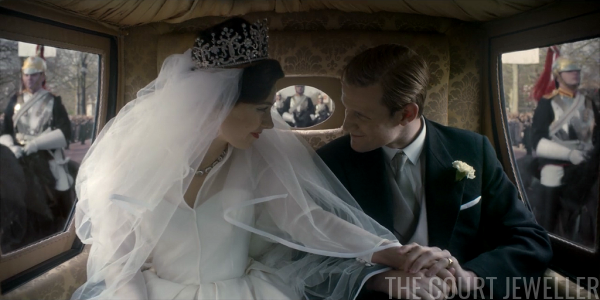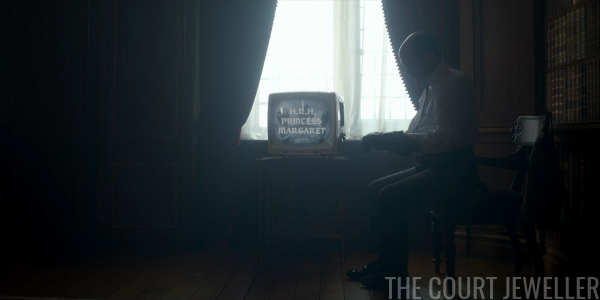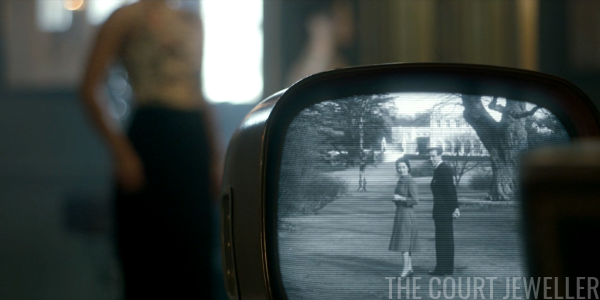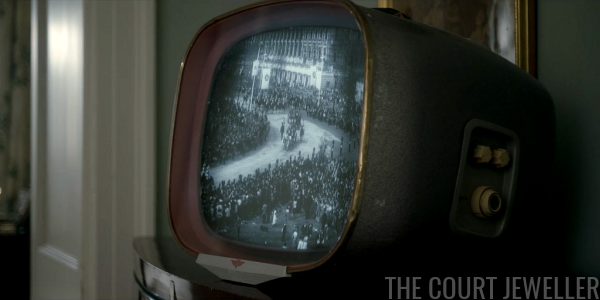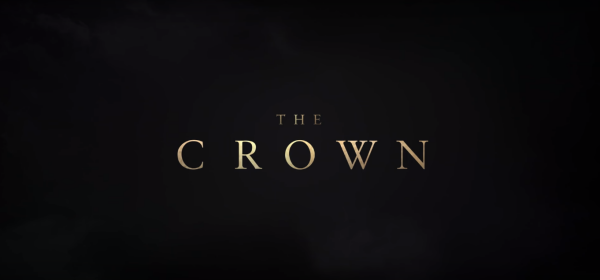
It’s time for our recap of “Dear Mrs. Kennedy,” the eighth episode of season two of The Crown — and we’ve got LOTS of replica jewels to critique! (Catch up on our previous recaps here!)
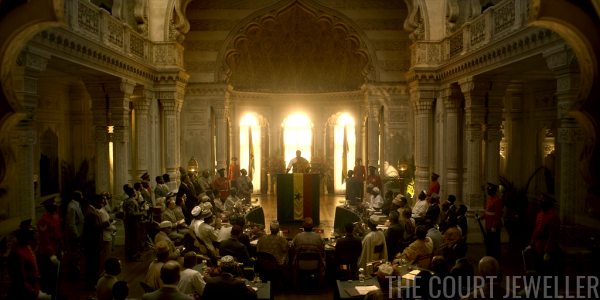
We open in Accra. President Kwame Nkrumah of Ghana is addressing leaders of other African nations, discussing the need to unite to promote the interests of Africa as a whole. (Nkrumah was a proponent of the Pan-Africanism movement, and he was one of the founding members of the Organization of African Unity, which officially formed in May 1963.) Ghana gained its independence in 1957, but the Queen remained head of state until 1960, when Nkrumah was elected president.
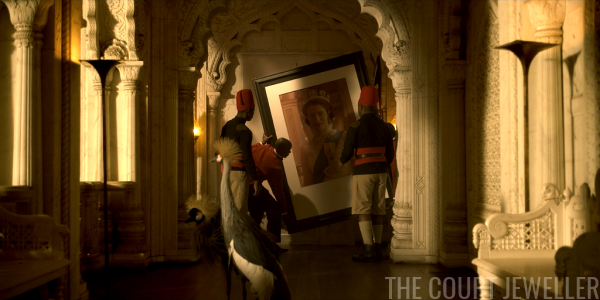
As he speaks, we see men removing the Gloriana portrait of the Queen from a government building…
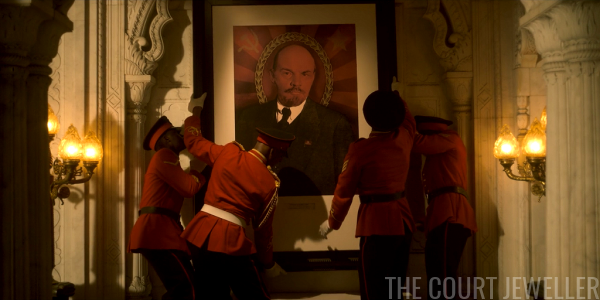
…and replacing it with a portrait of Vladimir Lenin. This visually sets up a central conflict of the episode: will Ghana remain allied with the Commonwealth and the West, or will it align itself with the Soviets? (This was a major question in 1961; President Nkrumah was a self-described Marxist, and that year he made a lengthy ten-week visit to the Soviet Union and its bloc nations.) Ghana was an important part of the Commonwealth and is still one of its largest member nations — of all Commonwealth nations, the country ranks just below Canada and just above Australia in population.
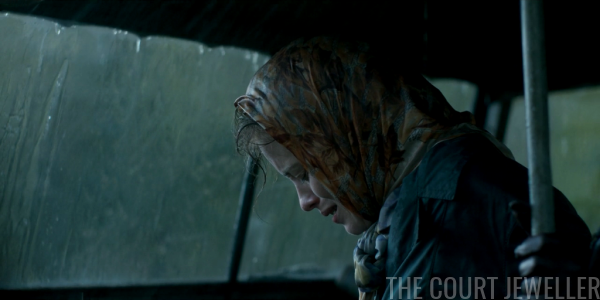
Back in Britain, the Queen is outdoors (at either Sandringham or Windsor, apparently) and she’s dealing with a sore ankle and a heightened sense of her own age and mortality.
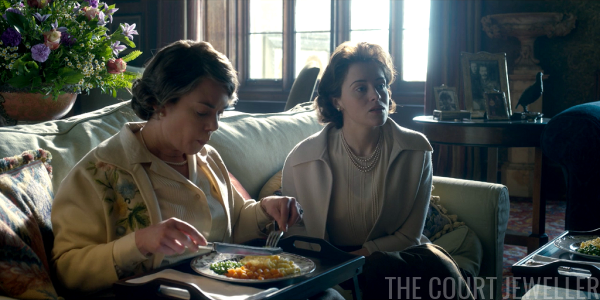
Indoors, and in pearls, she complains to the Queen Mother about her age. The Queen Mum dismisses her concerns, telling her she’s still young. (Really, she’s more invested in her mac and cheese. Again, the show paints the Queen Mum as a woman who simply sat on the couch and ate. So frustrating.)
The two of them turn their attention to the television, which is airing footage of the glamorous John and Jackie Kennedy, who will be heading to the UK soon.
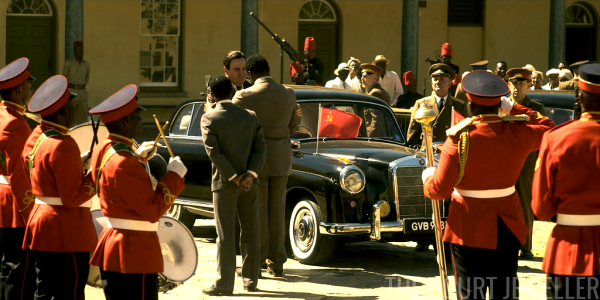
In Ghana, Nkrumah has drifted further from the West by hosting Leonid Brezhnev, one of the highest-ranking Soviet officials. This visit took place in February 1961.
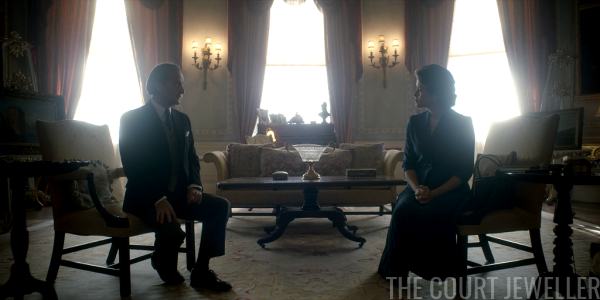
Macmillan drops by Buckingham Palace to discuss the government’s concerns about Ghana and the Commonwealth.
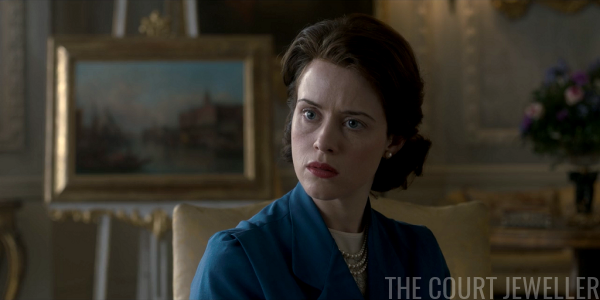
They also discuss the Kennedys, including Jackie’s successful charm offensive with President de Gaulle in Paris. HM, wearing her usual pearls, takes all of this in.
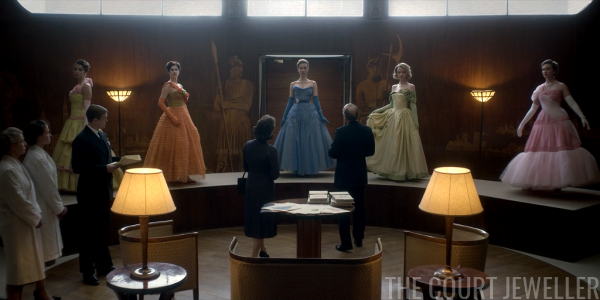
Clearly thinking about the elegant Jackie’s upcoming visit, Elizabeth makes a visit to her favorite designer, Norman Hartnell.
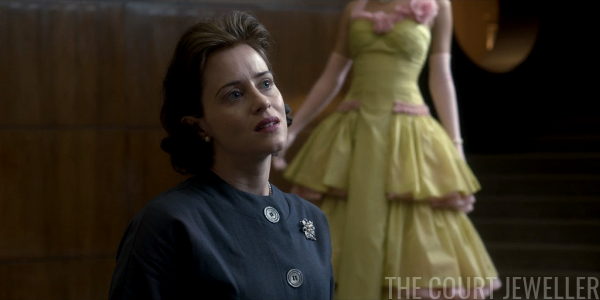
Wearing one of the production’s invented floral brooches, she falls in love with a chic blue strapless gown.
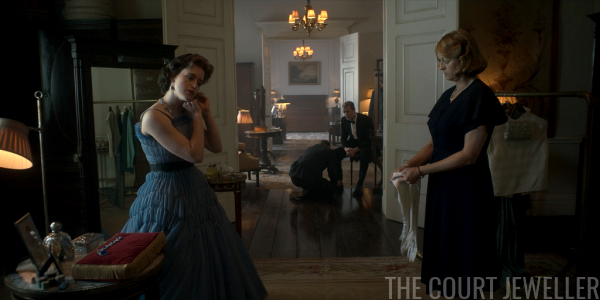
We see her getting dressed for the dinner — note that the gown has had straps added to make it more Queen-friendly. She’s also wearing the production’s replicas of the George VI Sapphires — also note the gems resting on a velvet cushion beside her.
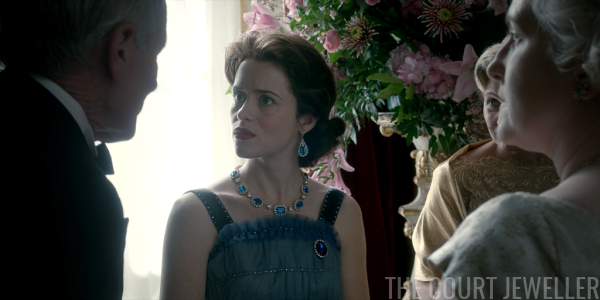
We get a better look here. The jewels are fairly faithful replicas of the original — I believe they’re sourced from Royal Exhibitions — and the entire ensemble is a close copy of what the Queen really wore for this dinner, which took place on June 5, 1961. The production’s iffy copy of the Albert Brooch is also pinned to the Queen’s dress.
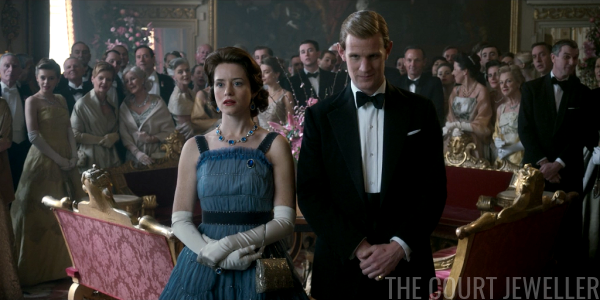
The entire assembly is breathless as they wait for the arrival of the Kennedys — well, mostly Jackie.
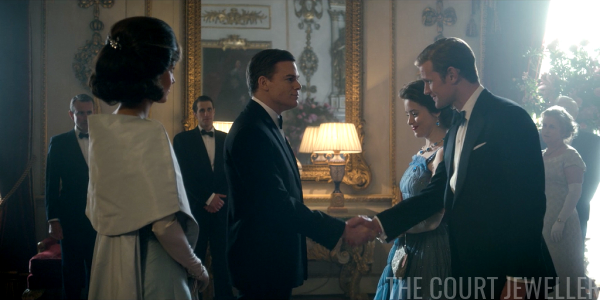
But the Kennedys botch the introductions. Jackie introduces herself first, and they get Elizabeth and Philip’s titles wrong. Adeane and Charteris squirm and cringe in the background.
This “bungling Americans” business all seems a bit unlikely to me. Have the writers forgotten that Jack lived in London on and off during his father’s pre-war tenure as the American ambassador to the Court of St. James?
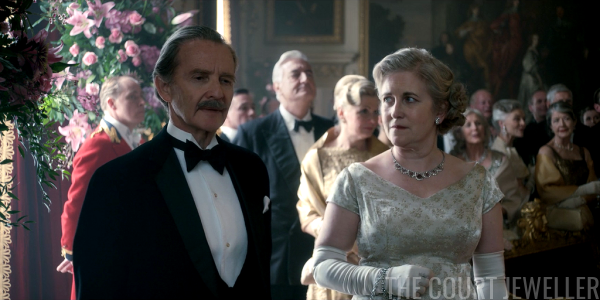
So do the Macmillans.
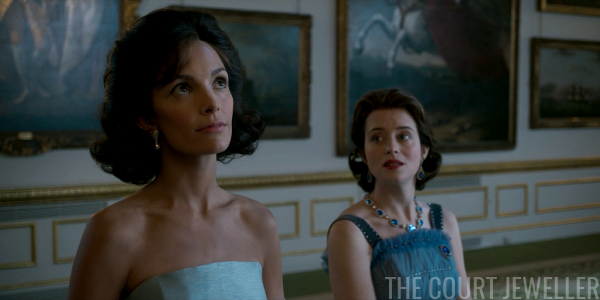
After dinner, Elizabeth takes Jackie on a tour of the palace. The production was far less faithful in copying Jackie’s ensemble from this event. Her real gown was sleeveless, but not strapless, and she wore diamonds clipped at her shoulders. She also wore her hair up, with an ornament placed toward the front of her hair.
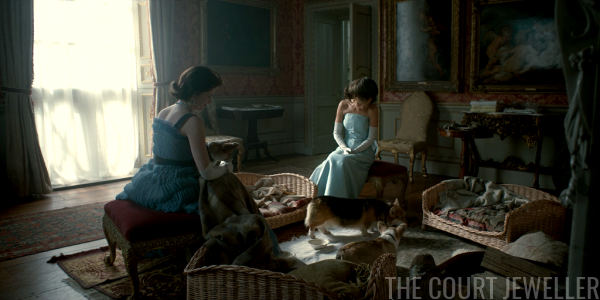
Unexpectedly, Elizabeth finds herself discovering common ground with the first lady. They’re both shy, and they both love animals. She shows Jackie some of the private rooms in the palace, and even lets her meet the corgis.
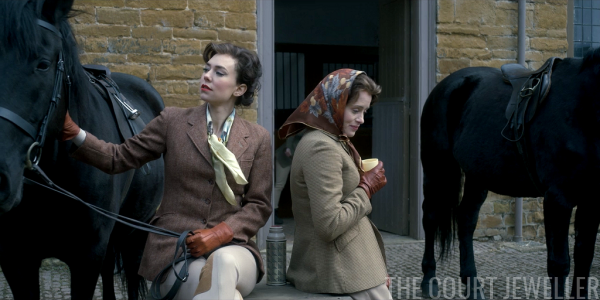
Margaret and Elizabeth meet up at the stables for a post-mortem on the Kennedy dinner. Elizabeth reveals that she surprised herself by liking Jackie. But Margaret drops a bomb — a friend said that, after the BP dinner, Jackie made disparaging remarks about Elizabeth at a dinner held at the home of Jackie’s sister, Lee Radziwill.
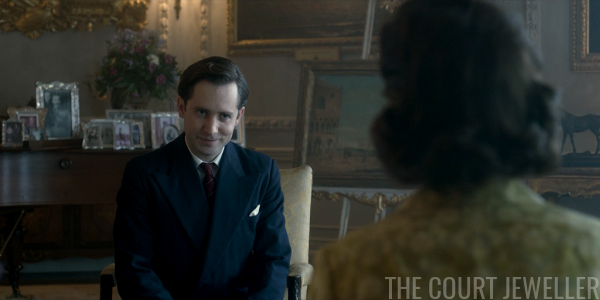
The friend in question is Lord Plunket, a close friend of the royals who also served as an equerry to both Elizabeth and her father. Elizabeth summons him to the palace, and he reluctantly repeats the statements that Jackie made at the dinner he attended. Jackie called the palace “dilapidated and sad,” and said that the Queen herself was “middle-aged and unintelligent.”
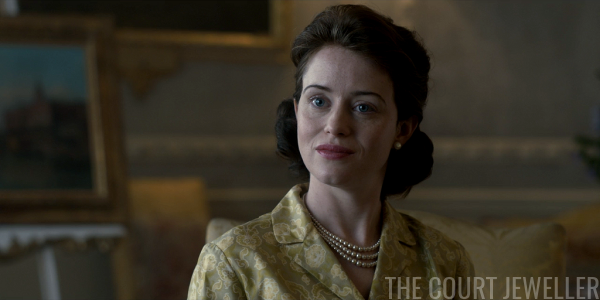
Pearl-clad Elizabeth receives the hurtful news with a carefully schooled expression.
(There’s no evidence that Jackie said these specific things, although she reportedly gossip a bit about the visit. Also: I think it’s interesting that the show chose to ignore the other big event happening in June 1961. Only three days after the Kennedy dinner, the royals attended the Duke of Kent’s grand, glamorous royal wedding at York Minster.)
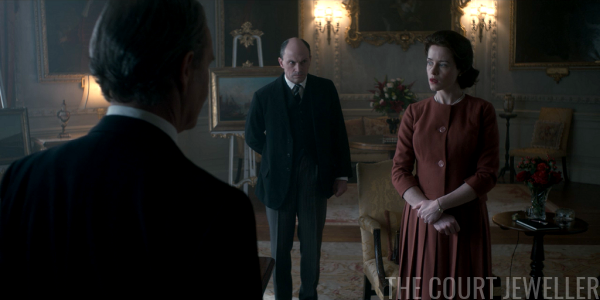
Other, more important matters are at hand, though: Macmillan arrives with news that President Nkrumah has been in Moscow. (Nkrumah’s visit to Moscow actually took place in September 1961.) Stung by Jackie’s comments, Elizabeth decides to prove that she can also be a charming influence when it matters. Over the objections of nearly everyone, she decides to go to Ghana herself.
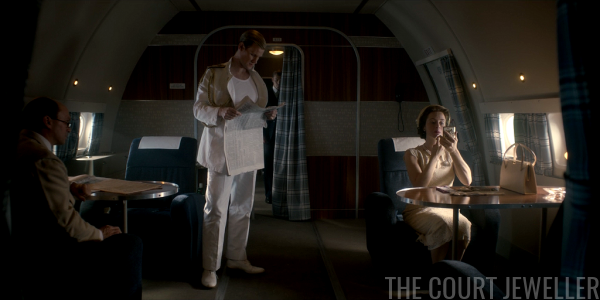
Philip reads press reports that question the wisdom of the Queen’s visit as the plane lands in Ghana.
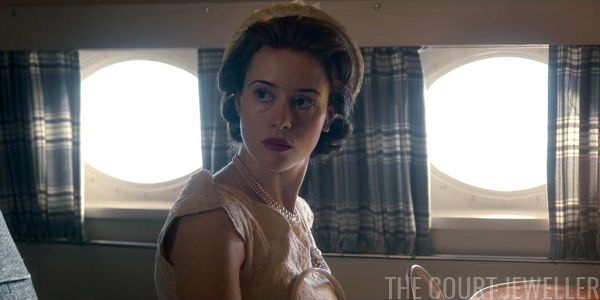
She’s indignant in the face of criticism. (This 12-day visit, which took place in November 1961, was indeed politically controversial, but it wasn’t as spontaneous as it’s depicted in the show. The Queen had originally been scheduled to visit Ghana in November 1959, but the trip had to be postponed because she was expecting Prince Andrew. She wasn’t even just going to Ghana — the lengthy trip also included visits to Sierra Leone and Gambia. Anyway.)
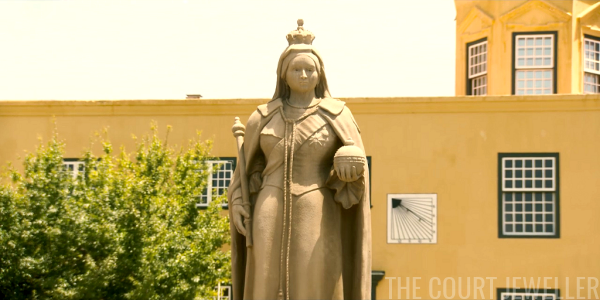
Philip, Elizabeth, and Adeane arrive in Accra under the watchful gaze of this weird statue of Queen Victoria.
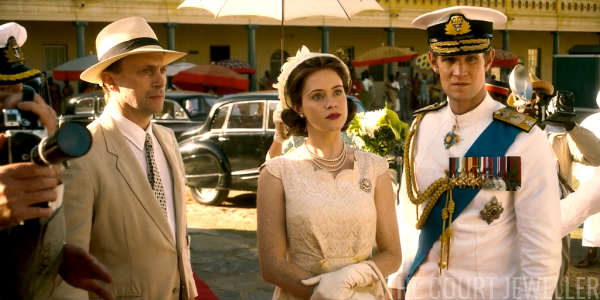
As the trio stands before President Nkrumah, photographers suddenly swarm the Queen, and Philip and Adeane hold them back. (This is beyond silliness. Because there were major security concerns about the visit, extra measures were taken; Duncan Sandys — a Commonwealth minister and Churchill’s son-in-law — even visited ahead of time to assess the security situation. The Queen would never have been left with only her husband and her private secretary to stand between her and swarming press.)
And as for the jewelry here — the Queen’s dress and hat are fairly decent versions of what she really wore for the arrival, but instead of this production-invented pearl cluster brooch, she wore the Dorset Bow Brooch.
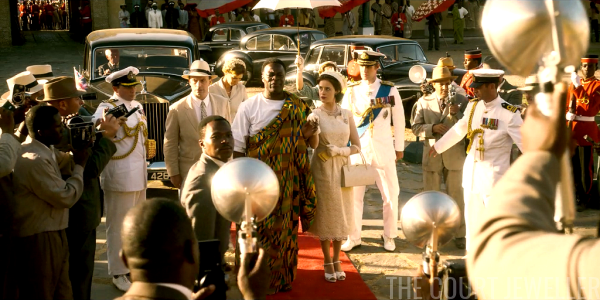
President Nkrumah turns the arrival ceremony into a strange, forced photo-op, clearly intending to use the Queen for his own PR purposes.
(The real welcoming ceremony from this visit was nothing like the show depicts. It was a grand event, including a large military display. It’s all there in the newsreel footage.)
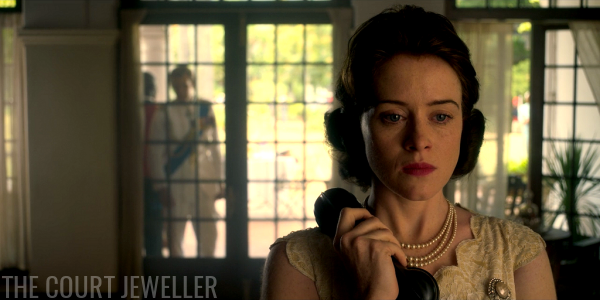
After the photo op, Elizabeth takes a call from Macmillan. He has bad news: Soviet engineers are in Ghana to help with the construction of a dam on the Volta River. (The construction of this hydroelectric dam did begin in 1961.) The Queen’s been played.
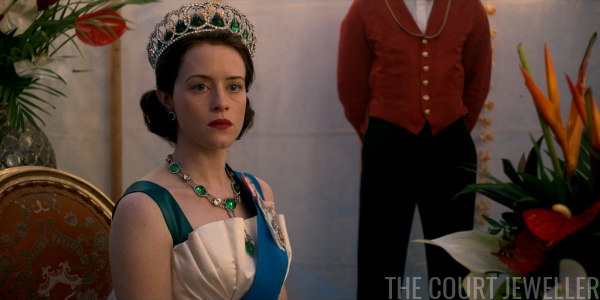
At a dinner that evening, the Queen is on edge. She’s wearing the production’s replica of the Vladimir Tiara, with its Cambridge emerald pendants, and the earrings and necklace from the Delhi Durbar Parure. (This dinner and dance really did happen, and this is a decent replica of the gown and jewels that the Queen really wore.)
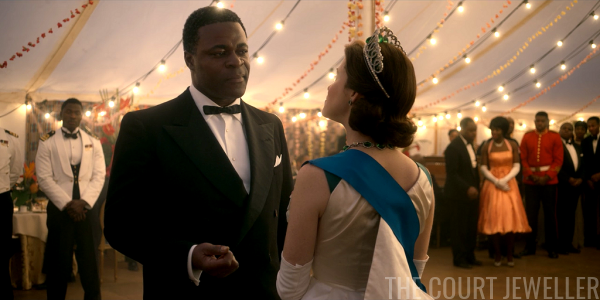
She and Nkrumah have a tense conversation on the dance floor. Again, we’ve got a replica tiara with a weird extended base. Not sure why they’ve done this — to make it easier to anchor in the actress’s hair?
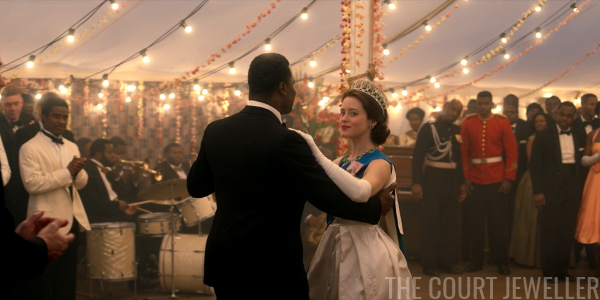
But Elizabeth disarms Nkrumah and the people of Ghana with a dance. She and Nkrumah glide effortlessly across the dance floor as the band plays “Begin the Beguine.”
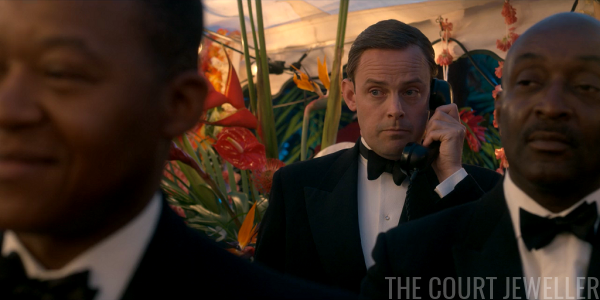
A stunned Charteris, who is on the phone with London, has to report that the Queen’s doing the fox trot with an African leader.
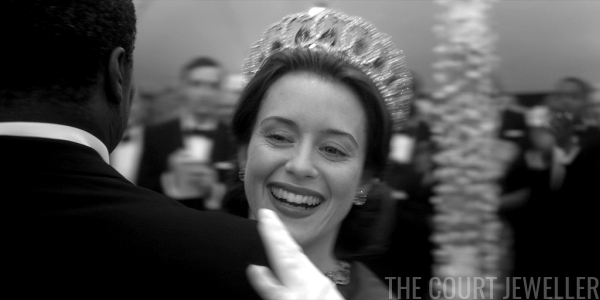
Press photographers capture her smiling face as they twirl around the floor. The charm offensive has worked.
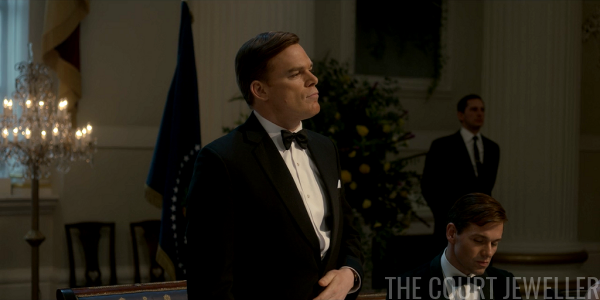
Meanwhile, across the Atlantic, the Kennedys attend an official dinner.
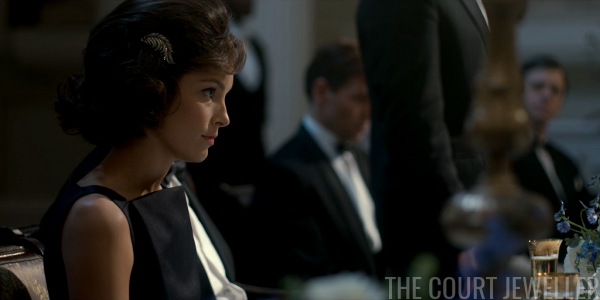
Jackie, who is angry as she notes her husband’s continually roving eye, is wearing a piece of real replica jewelry. This diamond leaf ornament was a wedding gift from her in-laws, Joe and Rose Kennedy. In 1962, Jackie quietly sold the diamond leaf brooches so that she could buy her famous diamond sunburst brooch from Wartski in London; she discreetly had copies made of the diamond leaves so that she wouldn’t offend the Kennedys.
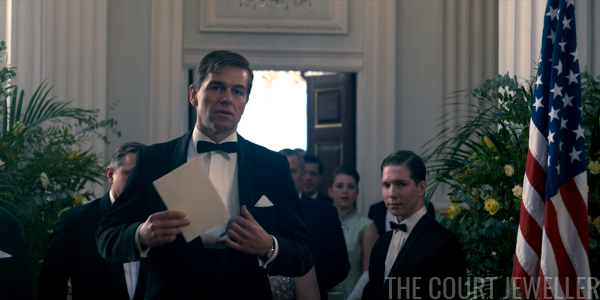
As the dinner ends, and Jack schmoozes with every lady in the room, Bobby Kennedy looks nervous. (I know many of you are British mystery fans, so you’ll probably recognize the actor playing Bobby. It’s Julian Ovenden, who played Andrew Foyle in Foyle’s War. Fun fact: Ovenden’s father used to be the real Queen’s chaplain.)
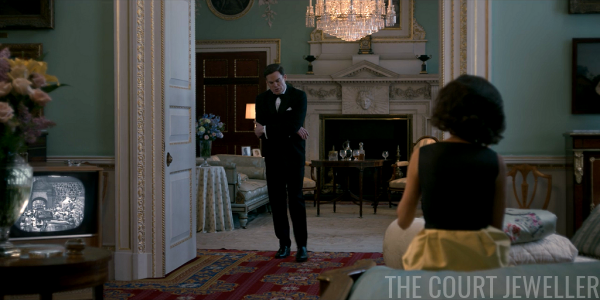
Jack and Jackie have a post-dinner fight as newsreel footage from the Queen’s Ghana visit plays in the background. Jack tells her that she’s influenced international politics once again — her negative comments have gotten back to the Queen, and he thinks they inspired her actions in Africa.
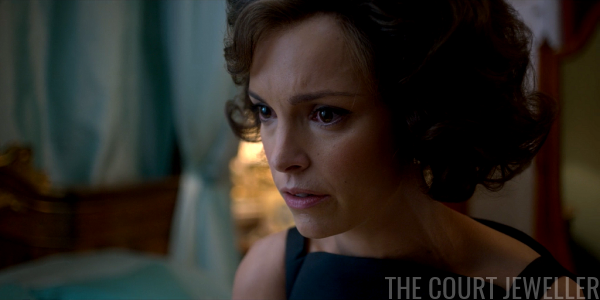
Jackie is mortified. She has to go back to London after her upcoming visit to India and Pakistan, and she’s got a luncheon scheduled at Buckingham Palace with the Queen. Uh-oh. (The visit in question took place in March 1962.)
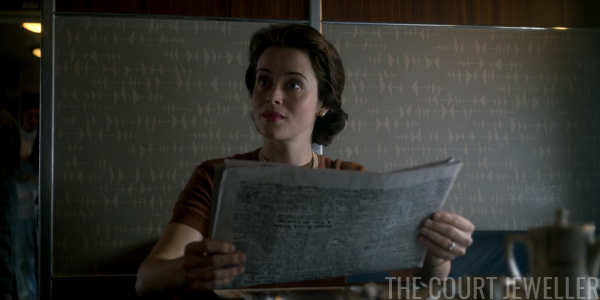
Meanwhile, Elizabeth is enjoying the positive reviews of her Ghana visit.
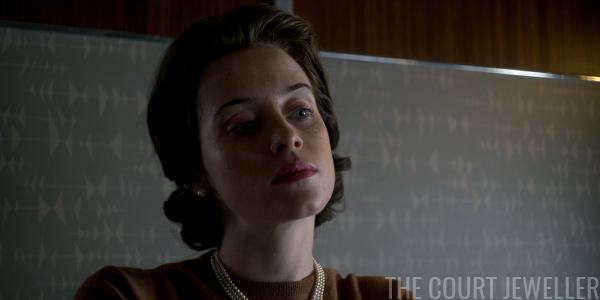
But Adeane also tells her that Jackie wants to meet privately before their scheduled lunch. They decide the meeting should happen at Windsor.
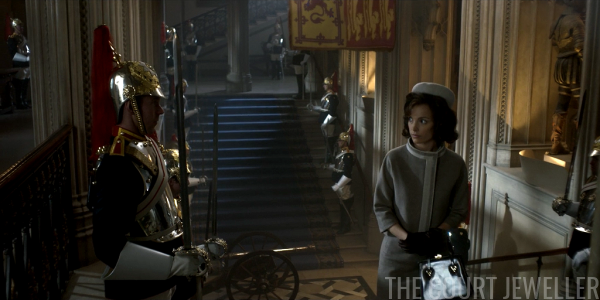
Jackie arrives at Windsor. (This would have been in March 1962, but it seems to have been an invented meeting. Other than the scheduled Buckingham Palace luncheon, Jackie seems to have spent her entire three-day London visit at the home of her sister, Lee.)
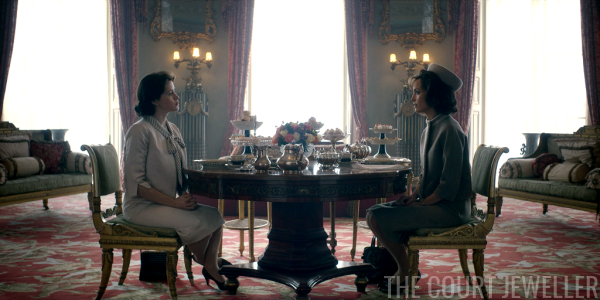
The two women sit down to tea.
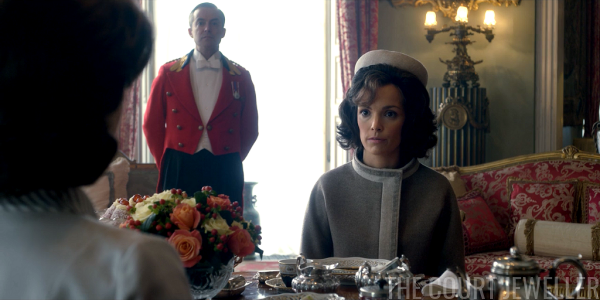
Jackie immediately apologizes for the things she said about the palace and the Queen. She says there are no excuses for her behavior, but she explains the stresses that she had been under on the trip; she was still dealing with the death of her son, Patrick, and the health problems of her husband. Jack was also angry with her for outshining him in Paris. And then there’s the kicker: to help her endure the trip, she was given drugs by a doctor. She was under the influence at the Radziwill dinner where she made the indiscreet remarks.
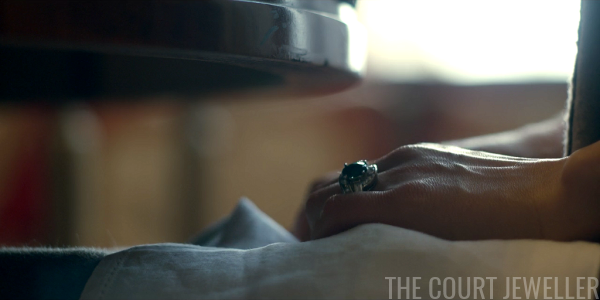
As she white-knuckles her way through the apology, we get a glimpse of Jackie’s famous diamond and emerald engagement ring.
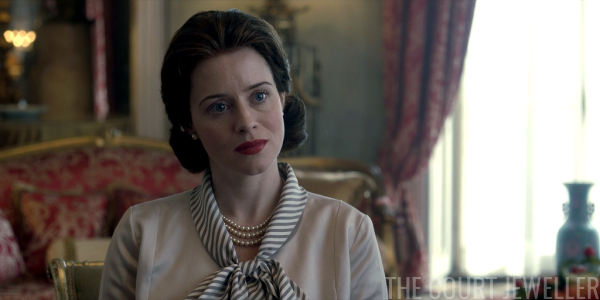
The Queen accepts the apology without saying much of anything in response.
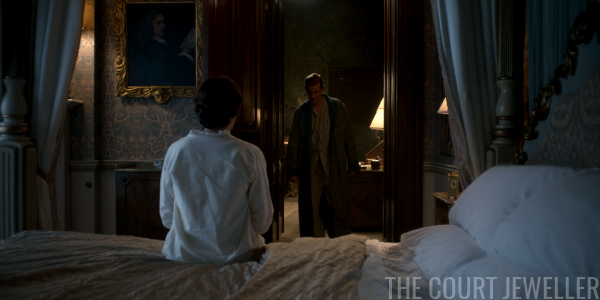
Later, she discusses the conversation with Philip. He compliments her for her strength — for having ice in her veins when she needs to.
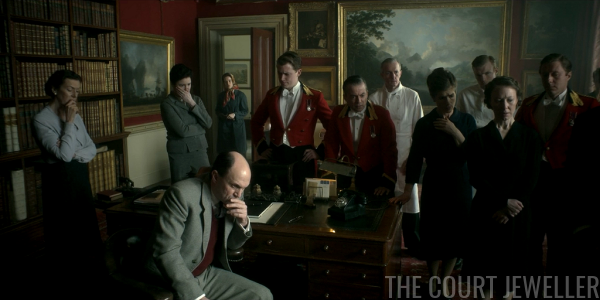
And then we fast forward more than a year. The Queen is in the forest again when she’s called back to the palace to hear horrible news: Kennedy has been shot in Dallas.
(The assassination took place in late November, and the news broke in the early afternoon in America. Wouldn’t it be dark out in England?)
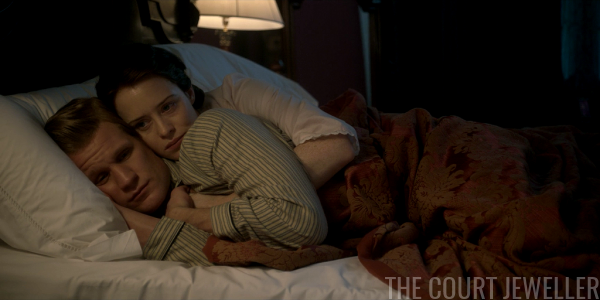
Elizabeth and Philip hold each other tightly after finding out that Kennedy has died.
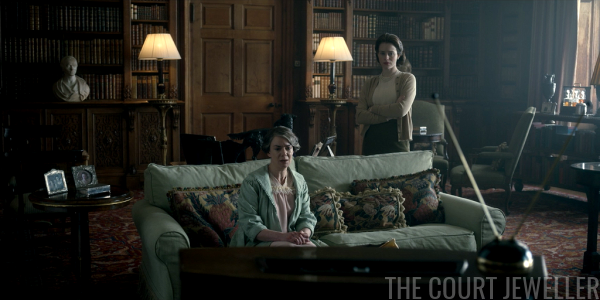
And the two Elizabeths discuss Jackie’s decision not to change out of her bloody clothes after Jack’s death.
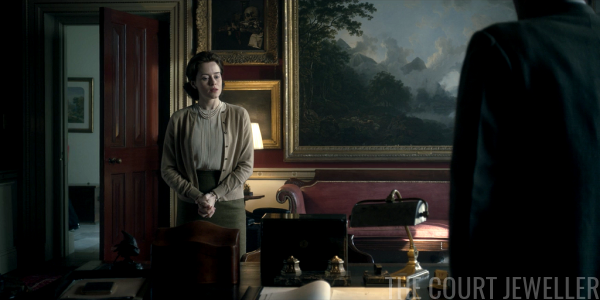
The Queen goes to Adeane and makes a bold request: she wants the court to officially mourn Kennedy for a week, and she wants the bell rung at Westminster Abbey in his honor, something usually done only for members of the royal family. Both of these things really did happen.
(Also of note: in real life, Elizabeth was several months pregnant with Prince Edward in November 1963. Philip attended Kennedy’s funeral in Washington on his wife’s behalf because of the pregnancy.)
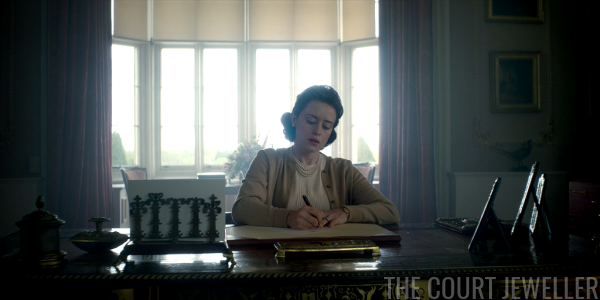
And then, Elizabeth goes into her study alone, so that she can send her condolences to Mrs. Kennedy.
